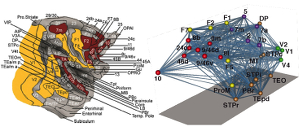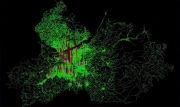|
|  |
|
 |
Research Highlights
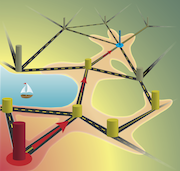
|

|
Predicting commuter flows in spatial
networks using a radiation model based on temporal ranges |
|
Nature Communications, 5, 5347 (2014) |
doi: 10.1038/ncomms6347
|
|
Understanding network flows such as commuter traffic in large transportation networks is
an ongoing challenge due to the complex nature of the transportation infrastructure and
of human mobility. Here we show a first-principles based method for traffic prediction
using a cost based generalization of the radiation model for human mobility, coupled with
a cost-minimizing algorithm for efficient distribution of the mobility fluxes through the
network. Using US census and highway traffic data we show that traffic can efficiently and
accurately be computed from a range-limited, network betweenness type calculation. The
model based on travel time costs captures the lognormal distribution of the traffic and
attains a high Pearson correlation coefficient (0.75) when compared to real traffic. Due
to its principled nature, this method can inform many applications related to human
mobility driven flows in spatial networks, ranging from transportation, through urban
planning to mitigation of the effects of catastrophic events.
|
|
Background:The cerebral cortex is divisible into many individual
areas, each exhibiting
distinct connectivity profiles, architecture, and physiological characteristics.
Interactions among cortical areas underlie higher sensory, motor, and cognitive functions.
Graph theory provides an important framework for understanding network properties of the
interareal weighted and directed connectivity matrix reported in recent studies.
Advances: We derive an exponential distance rule that predicts many binary and weighted features of
the cortical network, including efficiency of information transfer, the high specificity of
long-distance compared to short-distance connections, wire length minimization, and the existence
of a highly interconnected cortical core. We propose a bow-tie representation of the cortex,
which combines these features with hierarchical processing.
Outlook:The exponential distance rule has important implications for understanding scaling
properties of the cortex and developing future large-scale dynamic models of the cortex.
|
|
Recent advances in neuroscience have engendered interest in large-scale brain networks.
Using a consistent database of cortico-cortical connectivity, generated from hemisphere-wide,
retrograde tracing experiments in the macaque, we analyzed interareal weights and distances to
reveal an important organizational principle of brain connectivity. Using appropriate graph
theoretical measures, we show that although very dense (66%), the interareal network has strong
structural specificity. Connection weights exhibit a heavy-tailed lognormal distribution spanning
five orders of magnitude and conform to a distance rule reflecting exponential decay with interareal
separation. A single-parameter random graph model based on this rule predicts numerous features of
the cortical network: (1) the existence of a network core and the distribution of cliques,
(2) global and local binary properties, (3) global and local weight-based communication efficiencies
modeled as network conductance, and (4) overall wire-length minimization. These findings underscore
the importance of distance and weight-based heterogeneity in cortical architecture and processing.
|
|
The mathematical structure of Sudoku puzzles is akin to hard constraint satisfaction problems lying at the
basis of many applications, including protein folding and the ground-state problem of glassy spin systems.
Via an exact mapping of Sudoku into a deterministic, continuous-time dynamical system, here we show that
the difficulty of Sudoku translates into transient chaotic behavior exhibited by this system. We also show
that the escape rate κ, an invariant of transient chaos, provides a scalar measure of the puzzle's
hardness that correlates well with human difficulty ratings. Accordingly,
η = - log10 κ
can be used to define a "Richter"-type scale for puzzle hardness, with easy puzzles having
0 < η ≤ 1, medium
ones 1 < η ≤ 2, hard
with 2 < η ≤ 3 and ultra-hard with η > 3.
To our best knowledge, there are no known puzzles with
η > 4.
|
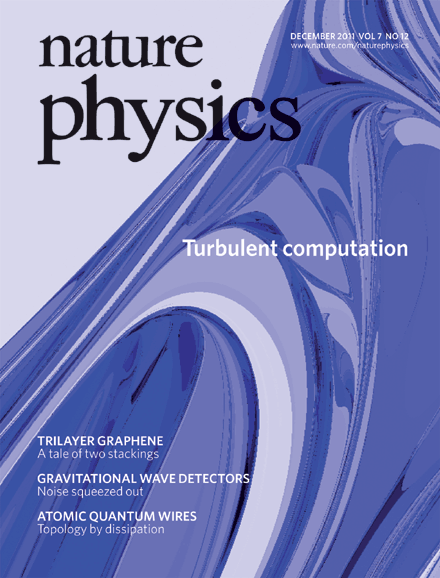
|

|
Turbulent computation: Optimization hardness as transient chaos in an
analog approach to constraint satisfaction |
|
Nature Physics 7, 966-970 (2011) |
doi:10.1038/nphys2105
|
|
Boolean satisfiability (k-SAT) is one of the most studied
optimization problems, as an efficient (that is, polynomial-time)
solution to k-SAT (for k > 2) implies efficient solutions
to a large number of hard optimization problems. Here we
propose a mapping of k-SAT into a deterministic continuous-time
dynamical system with a unique correspondence between
its attractors and the k-SAT solution clusters. We show
that beyond a constraint density threshold, the analog
trajectories become transiently chaotic, and the boundaries
between the basins of attraction of the solution clusters
become fractal, signalling the appearance of optimization
hardness. Analytical arguments and simulations indicate that
the system always finds solutions for satisfiable formulae
even in the frozen regimes of random 3-SAT
and of locked occupation problems (considered among the
hardest algorithmic benchmarks), a property partly due to the
system's hyperbolic character. The system finds solutions
in polynomial continuous time, however, at the expense of
exponential fluctuations in its energy function.
|
|
Betweenness centrality lies at the core of both transport and structural vulnerability properties of
complex networks; however, it is computationally costly, and its measurement for networks with millions
of nodes is nearly impossible. By introducing a multiscale decomposition of shortest paths, we show that
the contributions to betweenness coming from geodesics not longer than L obey a characteristic scaling
versus L, which can be used to predict the distribution of the full centralities. The method is also
illustrated on a real-world social network of 5.5 Million nodes and 27 Million links.
|
|
Uniform sampling from graphical realizations of a given degree sequence is a fundamental component in simulation-based
measurements of network observables, with applications ranging from epidemics, through social networks to Internet
modeling. Existing graph sampling methods are either link-swap based (Markov-Chain Monte Carlo algorithms) or stubmatching
based (the Configuration Model). Both types are ill-controlled, with typically unknown mixing times for link-swap
methods and uncontrolled rejections for the Configuration Model. Here we propose an efficient, polynomial time algorithm
that generates statistically independent graph samples with a given, arbitrary, degree sequence. The algorithm provides a
weight associated with each sample, allowing the observable to be measured either uniformly over the graph ensemble, or,
alternatively, with a desired distribution. Unlike other algorithms, this method always produces a sample, without backtracking
or rejections. Using a central limit theorem-based reasoning, we argue, that for large N, and for degree sequences
admitting many realizations, the sample weights are expected to have a lognormal distribution. As examples, we apply our
algorithm to generate networks with degree sequences drawn from power-law distributions and from binomial
distributions.
|
|
We consider the effect of network topology on the optimality of packet routing which is quantified
by γ , the
rate of packet insertion beyond which congestion and queue growth occurs. We show that for any network,
there exists an absolute upper bound, expressed in terms of vertex separators, for the scaling of γ with network
size N, irrespective of the static routing protocol used. We then derive an estimate to this upper bound for
scale-free networks and introduce a static routing protocol, the "hub avoidance protocol", which, for large
packet insertion rates is superior to shortest path routing.
|
|
Most mathematical models for the spread of disease use differential equations based on uniform
mixing assumptions or ad hoc models for the contact process. Here we explore the use of
dynamic bipartite graphs to model the physical contact patterns
that result from movements of individuals between specific
locations. The graphs are generated by large-scale individual-based urban traffic simulations built
on actual census, land-use and population-mobility data. We find that the contact network
among people is a strongly connected small-world-like graph
with a well-defined scale for the degree distribution. However,
the locations graph is scale-free, which allows highly efficient
outbreak detection by placing sensors in the hubs of the locations
network. Within this large-scale simulation framework, we then
analyse the relative merits of several proposed mitigation strategies for smallpox spread. Our
results suggest that outbreaks can be contained by a strategy of targeted vaccination combined with
early detection without resorting to mass vaccination of a
population.
|
|
We define gradient networks as directed graphs formed by local gradients of a
scalar field distributed on the nodes of a substrate network G. We derive an
exact expression for the in-degree distribution of the gradient network when
the substrate is a binomial (Erdős-Rényi) random graph, G(N,p).
Using this
expression we show that the in-degree distribution R(l) of gradient graphs on
G(N,p) obeys the power law R(l)~1/l for arbitrary,
i.i.d. random scalar fields.
We then relate gradient graphs to congestion tendency in network flows and show
that while random graphs become maximally congested in the large network size
limit, scale-free networks are not, forming fairly efficient substrates for
transport. Combining this with other constraints, such as uniform edge cost,
we obtain a plausible argument in form of a selection principle, for why a number
of spontaneously evolved massive networks are scale-free.
|
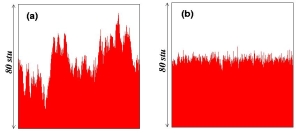
|

|
Parallel Computing |
|
Science 299, 677 (2003).
|
|
In a parallel discrete-event simulation (PDES) scheme, tasks are distributed among processing
elements (PEs), whose progress is controlled by a synchronization scheme. For lattice systems with
short-range interactions, the progress of the conservative PDES scheme is governed by the
Kardar-Parisi-Zhang equation from the theory of non-equilibrium surface growth. Although the
simulated (virtual) times of the PEs progress at a nonzero rate, their standard deviation (spread)
diverges with the number of PEs, hindering efficient data collection. We show that weak random
interactions among the PEs can make this spread nondivergent. The PEs then progress at a nonzero,
near-uniform rate without requiring global synchronizations.
|

|

|
Fluid Dynamics: Catching Particles with a Stick |
|
Phys. Rev. Lett. 89, 164501 (2003).
|
|
We investigate the effects of finite size and inertia of a small spherical particle immersed in an
open unsteady flow which, for ideal tracers, generates transiently chaotic trajectories. The inertia
effects may strongly modify the chaotic motion to the point that attractors may appear in the
configuration space. These studies are performed in a model of the two-dimensional flow past a
cylindrical obstacle. The relevance to modeling efforts of biological pathogen transport in
large-scale flows is discussed. Since the tracer dynamics is sensitive to the particle inertia and
size, simple geometric setups in such flows could be used as a particle mixture segregator separating
and trapping particles.
|
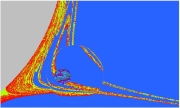
|

|
Chaotic Flow: The Physics of Species Coexistence |
|
Proc. Natl. Acad. Sci. USA
97, 13661 (2000).
|
|
Hydrodynamical phenomena play a keystone role in the population dynamics of passively advected
species such as phytoplankton and replicating macromolecules. Recent developments in the field of
chaotic advection in hydrodynamical flows encourage us to revisit the population dynamics of species
competing for the same resource in an open aquatic system. If this aquatic environment is homogeneous
and well-mixed then classical studies predict competitive exclusion of all but the most perfectly
adapted species. In fact, this homogeneity is very rare, and the species of the community (at least
on an ecological observation time scale) are in nonequilibrium coexistence. We argue that a peculiar
small-scale, spatial heterogeneity generated by chaotic advection can lead to coexistence. In open
flows this imperfect mixing lets the populations accumulate along fractal filaments, where competition
is governed by an "advantage of rarity" principle. The possibility of this generic coexistence sheds
light on the enrichment of phytoplankton and the information integration in early macromolecule evolution.
|

|

|
Nanoscale Fluctuations at Solid Surfaces |
|
Physics Today
52, 24 (1999).
|
|
On the nanometer scale, a seemingly smooth crystalline
surface is not only bumpy, it's also in motion. Tiny
mesas and depressions appear and disappear; escarpments
range over the surface like waves on a beach. These
thermal fluctuations are visible, thanks to advances in
imaging techniques, which exploit electrons to divine the
nanoscale motions. But although experiments
can capture the spatial structure of surface fluctuations
with atomic resolution, they lack the temporal resolution
to follow the hops of individual atoms. Instead,
observations yield a set of parameters that characterize
how the surface changes on longer, millisecond timescales.
Can these parameters be derived from physical arguments
to predict the nanoscopic behavior of surfaces? With
so much activity at the atomic level, building a model
based on the behavior of individual atoms is too difficult.
Moreover, we do not know how all the atomic degrees of
freedom couple to the motion of surface features formed by
tens to hundreds of atoms.
Fortunately, it turns out that a thermodynamic
approach - one that treats fluctuations as the larger-scale
manifestations of atoms moving in equilibrium - can successfully
account for the observed behavior. This
approach, which is the subject of this article, has more
than academic interest. As devices shrink in size to the
nanometer scale, the measurement, characterization, and
understanding of how tiny surface features evolve will be
crucial in determining the reliability and utility of nanostructures.
|
|


